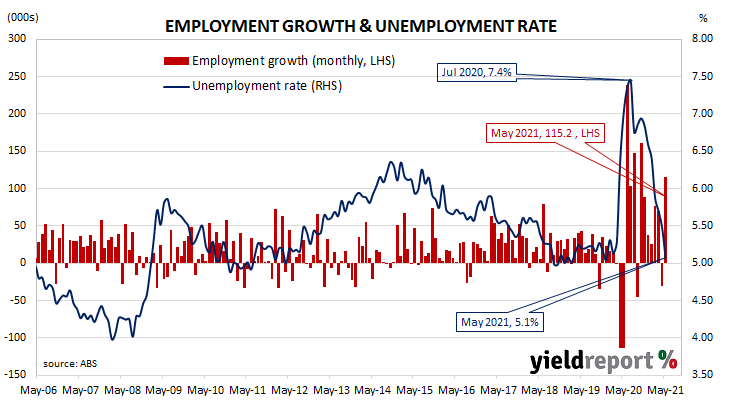Summary: Total employment increases by 115,200 in May; employment number change more than expected; “stunning outcome” a snap-back from soft Easter period; participation rate rise, near all-time high; fewer people seeking work with larger available workforce sends jobless rate to 5.1%; more part-time & full-time jobs; aggregate work hours rise 1.4%; underemployment rate falls to 7.4%.
Australia’s period of falling unemployment came to an end in early 2019 when the jobless rate hit a low of 4.9%. It then averaged around 5.2% through to March 2020, bouncing around in a range from 5.1% to 5.3%. Leading indicators such as ANZ’s Job Ads survey and NAB’s capacity utilisation estimate suggested the unemployment rate would rise in the June 2020 quarter and it did so, sharply. The jobless rate peaked in July 2020 before falling below 7% a month later. Since then, it has continued to trend lower.
“This stunning outcome represents a snap-back from a softer period over the Easter holiday,” said Westpac senior economist Justin Smirk. He noted it was “also consistent with the robust outcomes seen in the leading indicators of employment, including job vacancies and the business surveys.”

Domestic Treasury bond yields jumped on the day, aided by higher US Treasury bond yields in overnight trading. By the end of the day, 3-year and 10-year ACGB yields had each gained 10bps to 0.34% and 1.66% respectively while the 20-year yield finished 6bps higher at 2.28%.
In the cash futures market, expectations of a change in the actual cash rate remained fairly stable. At the end of the day, contract prices implied the cash rate would gradually rise from its current rate of 0.03% to around 0.23% by November 2022.
The participation rate recovered, almost back to March’s record high, rising from April’s revised rate of 65.9% to 66.2% as the total available workforce increased by 62,200 to 13,826,300. The number of unemployed persons fell by 53,000 to 701,100; the lower unemployment number in conjunction with more people in the workforce led to a drop in the unemployment rate from 5.5% to 5.1%.

